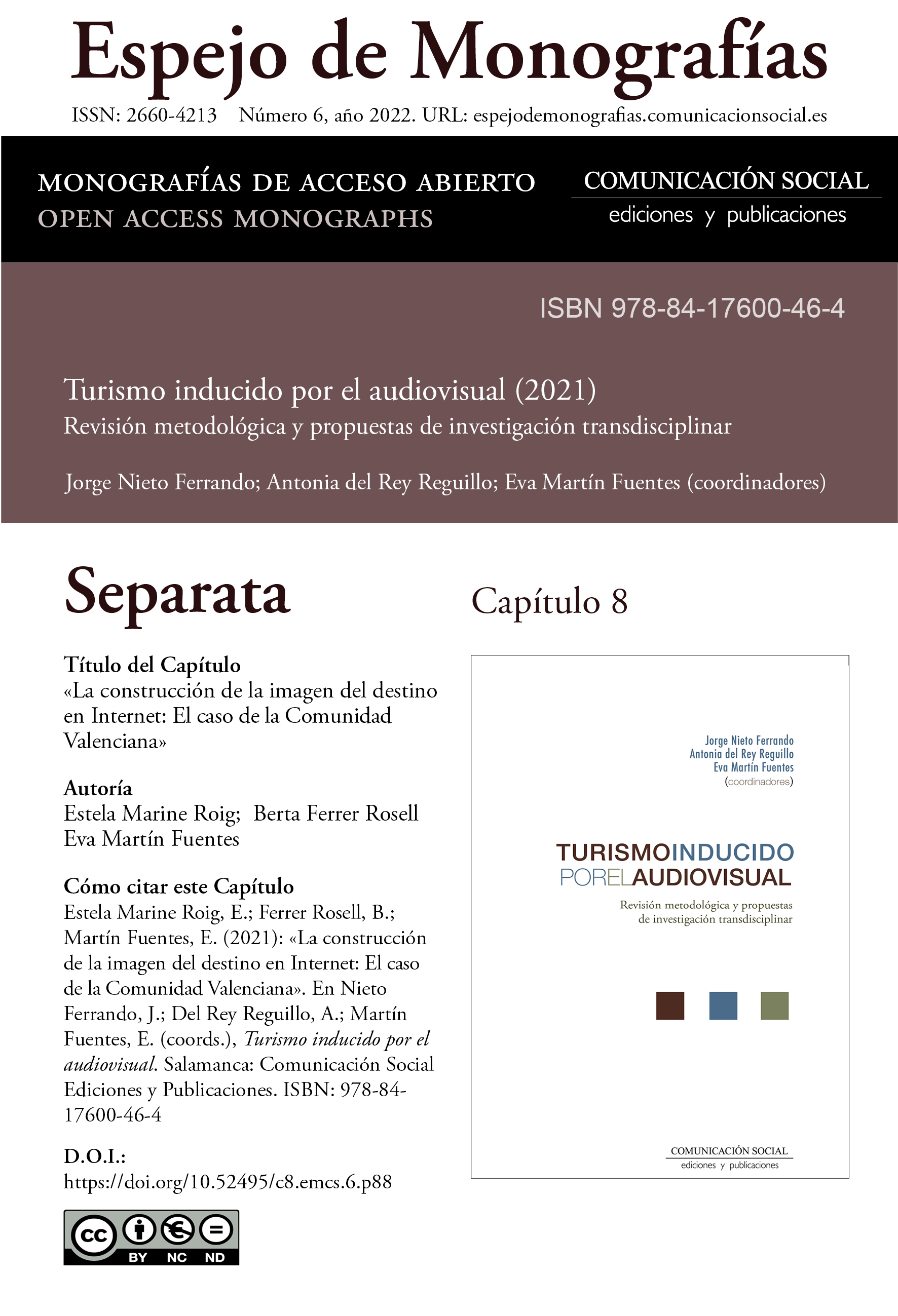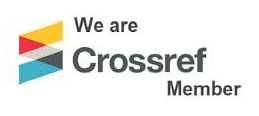Capítulo 8. La construcción de la imagen del destino en Internet: El caso de la Comunidad Valenciana
DOI:
https://doi.org/10.52495/c8.emcs.6.p88Resumen
El objetivo del presente estudio es proponer un marco teórico y metodológico para analizar la imagen en línea de los destinos turísticos a partir de contenido audiovisual y textual generado por los viajeros y compartido en las redes sociales. El marco se aplica a una muestra aleatoria de 375.000 reseñas, escritas en inglés, entre 2014 y 2018, por visitantes de la Comunidad Valenciana.
Palabras clave: Imagen de un destino; reseña de viaje en línea; datos masivos; minería de opiniones; análisis de sentimientos, turismo, audiovisual.
Descargas
Citas
Agapito, D.; P. Oom do Valle; J. da Costa Mendes (2013): «The cognitive-affective-conative model of destination image: A confirmatory analysis», Journal of Travel and Tourism Marketing, vol. 30, núm. 5, pp. 471-481.
Analysts (2018): The state of the American traveler. Destinations edition (Vol. 27). San Francisco, CA: Destination Analysts.
Analysts (2019): The state of the American traveler. Destinations edition (Vol. 31). San Francisco, CA: Destination Analysts.
Andreu, L.; J.E. Bigné; C. Cooper (2000): «Projected and perceived image of Spain as a tourist destination for British travellers», Journal of Travel & Tourism Marketing, vol. 9, núm. 4, pp. 47-67.
Back, K.J.; S.C. Parks (2003): «A brand loyalty model involving cognitive, affective, and conative brand loyalty and customer satisfaction», Journal of Hospitality & Tourism Research, vol. 27, núm. 4, pp. 419-435.
Baloglu, S.; K.W. McCleary (1999): «A model of destination image formation», Annals of Tourism Research, vol. 26, núm. 4, pp. 868-897.
Basaran, U. (2016): «Examining the relationships of cognitive, affective, and conative destination image: A research on Safranbolu, Turkey», International Business Research, vol. 9, núm. 5, pp. 164-179.
Beerli, A.; J.D. Martín (2004): «Factors influencing destination image», Annals of Tourism Research, vol. 31, núm. 3, pp. 657-681.
Bigné, J.E.; M.I. Sánchez; J. Sánchez (2001): «Tourism image, evaluation variables and after purchase behaviour: inter-relationship», Tourism Management, vol. 22, núm. 6, pp. 607-616.
Boulding, K.E. (1956): The image: Knowledge in life and society. Ann Arbor, MI: University of Michigan Press.
Boulding, K.E. (1959): «National images and international systems», Journal of Conflict Resolution, vol. 3, núm. 2, pp. 120-131.
Britton, R.A. (1979): «The image of the Third World in tourism marketing», Annals of Tourism Research, vol. 6, núm. 3, pp. 318-329.
Buhalis, D. (2000): «Marketing the competitive destination of the future», Tourism Management, vol. 21, núm. 1, pp. 97-116.
Chen, R.; Z. Zhou; G. Zhan; N. Zhou (2020): «The impact of destination brand authenticity and destination brand self-congruence on tourist loyalty: The mediating role of destination brand engagement», Journal of Destination Marketing & Management, vol. 15, artículo 100402.
Chon, K.S. (1990): «The role of destination image in tourism: A review and discussion», The Tourist Review, vol. 45, núm. 2, pp. 2-9.
Çoban, S. (2012): «The effects of the image of destination on tourist satisfaction and loyalty: The case of Cappadocia», European Journal of Social Sciences, vol. 29, núm. 2, pp. 222-232.
Crompton, J.L. (1979): «An assessment of the image of Mexico as a vacation destination and the influence of geographical location upon that image», Journal of Travel Research, vol. 17, pp. 18-23.
D’Arco, M.; L. Lo Presti; V. Marino; R. Resciniti (2019): «Embracing AI and Big Data in customer journey mapping: from literature review to a theoretical framework», Innovative Marketing, vol. 15, núm. 4, pp. 102-115.
Elliot, S.; N. Papadopoulos; L. Szamosi (2013): «Studying place image: an interdisciplinary and holistic approach», Anatolia, vol. 24, núm. 1, pp. 5-16.
Eurobarometer (2016): Flash Eurobarometer 432: Preferences of Europeans towards tourism. Brussels: European Commission.
Eurostat (2015): Regions in the European Union: Nomenclature of territorial units for statistics (NUTS). Luxembourg: Publications Office of the European Union.
Eurostat (2019): Tourism. In Eurostat regional yearbook (pp. 143-153). Luxembourg: Publications Office of the European Union.
Fakeye, P.C.; J.L. Crompton (1991): «Image differences between prospective, first-time, and repeat visitors to the Lower Rio Grande Valley», Journal of Travel Research, vol. 30, núm. 2, pp. 10-16.
Ferrer-Rosell, B.; E. Marine-Roig (2020): «Projected versus perceived destination image», Tourism Analysis, vol. 25, núm. 2-3, pp. 227-237.
Gartner, W.C. (1986): «Temporal influences on image change», Annals of Tourism Research, vol. 13, núm. 4, pp. 635-644.
Gartner, W.C. (1993): «Image formation process», Journal of Travel & Tourism Marketing, vol. 2, núm. 2-3, pp. 191-215.
Gartner, W.C.; J.D. Hunt (1987): «An analysis of state image change over a twelve-year period (1971-1983)», Journal of Travel Research, vol. 26, núm. 2, pp. 15-19.
Gretzel, U.; K.H. Yoo (2008): «Use and impact of online travel reviews», en P. O’Connor, Höpken, W. y U. Gretzel (Eds.), Information and Communication Technologies in Tourism 2008 (pp. 35-46). Vienna: Springer Vienna.
Gunn, C.A. (1972): Vacationscape: Designing tourist regions. Austin: Bureau of Business Research, University of Texas.
Hilgard, E. (1980): «The trilogy of mind: Cognition, affection, and conation», Journal of the History of the Behavioral Sciences, vol. 16, núm. 2, pp. 107-117.
Hlee, S.; H. Lee; C. Koo (2018): «Hospitality and tourism online review research: A systematic analysis and heuristic-systematic model», Sustainability, vol. 10, núm. 4, artículo 1141.
Jiang, Y.; H. Ramkissoon; F.T. Mavondo; S. Feng (2017): «Authenticity: The link between destination image and place attachment», Journal of Hospitality Marketing & Management, vol. 26, núm. 2, pp. 105-124.
Krippendorf, K. (2004): Content analysis: An introduction to its methodology. London: Sage Publications.
Kwok, L.; K.L. Xie; T. Richards (2017): «Thematic framework of online review research: A systematic analysis of contemporary literature on seven major hospitality and tourism journals», International Journal of Contemporary Hospitality Management, vol. 29, núm. 1, pp. 307-354.
Lai, K.; X. Li (2016): «Tourism destination image: Conceptual problems and definitional solutions», Journal of Travel Research, vol. 55, núm. 8, pp. 1065-1080.
Li, X.; R. Law (2020): «Network analysis of big data research in tourism», Tourism Management Perspectives, vol. 33, artículo 100608.
Liang, T.P.; Y.H. Liu (2018): «Research landscape of business intelligence and big data analytics: A bibliometrics study», Expert Systems with Applications, vol. 111, 2-10.
Liu, B. (2011): Web data mining: Exploring hyperlinks, contents, and usage data. Berlin: Springer Berlin Heidelberg.
Lynch, K. (1960): The image of the city. Cambridge: The MIT Press.
Marine-Roig, E. (2010): «Los «Travel Blogs» como objetos de estudio de la imagen percibida de un destino [Travel blogs as objects of study of the perceived destination image]», en A.J. Guevara Plaza; A. Aguayo Maldonado; J.L. Caro Herrero (Eds.), Turismo y Tecnologías de la Información y las Comunicaciones (pp. 61-76). Málaga: Facultad de Turismo.
Marine-Roig, E. (2011a): «Innovation and identity in Barcelona’s tourist image as represented by souvenirs», Catalan Journal of Communication & Cultural Studies, vol. 3, núm. 2, pp. 175-193.
Marine-Roig, E. (2011b): «The image and identity of the Catalan coast as a tourist destination in twentieth-century tourist guidebooks», Journal of Tourism and Cultural Change, vol. 9, núm. 2, pp. 118-139.
Marine-Roig, E. (2015): «Identity and authenticity in destination image construction», Anatolia: An International Journal of Tourism and Hospitality Research, vol. 26, núm. 4, pp. 574-587.
Marine-Roig, E. (2017a): «Measuring destination image through travel reviews in search engines», Sustainability, vol. 9, núm. 8, artículo 1425.
Marine-Roig, E. (2017b): «Online travel reviews: A massive paratextual analysis», en Z. Xiang; D.R. Fesenmaier (Eds.), Analytics in Smart Tourism design: Concepts and methods (pp. 179-202). Heidelberg: Springer.
Marine-Roig, E. (2019): «Destination image analytics through traveller-generated content», Sustainability, vol. 11, núm. 12, artículo 3392.
Marine-Roig, E.; S. Anton Clavé (2016): «A detailed method for destination image analysis using user-generated content», Information Technology & Tourism, vol. 15, núm. 4, pp. 341-364.
Marine-Roig, E.; B. Ferrer-Rosell (2018): «Measuring the gap between projected and perceived destination images of Catalonia using compositional analysis», Tourism Management, vol. 68, pp. 236-249.
Marine-Roig, E.; E. Martin-Fuentes; B. Ferrer-Rosell (2019): «A framework for destination image analytics», en J. Pesonen; J. Neidhardt (Eds.), Information and Communication Technologies in Tourism 2019 (pp. 158-171). Cham: Springer International Publishing.
Niñerola, A.; M.V. Sánchez-Rebull; A.B. Hernández-Lara (2019): «Tourism research on sustainability: A bibliometric analysis», Sustainability, vol. 11, núm. 5, artículo 1377.
Pearce, D. (1997): «Tourism and the autonomous communities in Spain», Annals of Tourism Research, vol. 24, núm. 1, pp. 156-177.
Pocock, D.; R. Hudson (1978): Images of the urban environment. London: Macmillan.
R.A.E. (2019): Diccionario de la lengua española. Edición del Tricentenario. Consultado en http://die.rae.es
Rapoport, A. (1977): Human aspects of urban form. Oxford: Pergamon Press.
Ritchie, J.R.B.; G.I. Crouch (2000): «The competitive destination: A sustainability perspective», Tourism Management, vol. 21, núm. 1, pp. 1-7.
Smelser, N.J.; P.B. Baltes (2001): International encyclopedia of social & behavioral sciences. Oxford: Pergamon.
Solá, E.F. (1992): «The white paper on Valencian tourism», Tourism Management, vol. 13, núm. 1, pp. 45-49.
Sotiriadis, M.D. (2017): «Sharing tourism experiences in social media: A literature review and a set of suggested business strategies», International Journal of Contemporary Hospitality Management, vol. 29, núm. 1, pp. 179-225.
Staszak, J.F.; E. Marine-Roig (traductora) (2018): «Representacions del turisme al cinema: Introducció al dossier», Via@ Tourism Review, vol. 2018, núm. 14, consultado en https://journals.openedition.org/viatourism/2922
Stemler, S. (2001): «An overview of content analysis», Practical Assessment, Research & Evaluation, vol. 7, núm. 17, consultado en http://pareonline.net/getvn.asp?v=7&n=17
TripAdvisor (2019a): Restaurants in Valencian Country. Consultado 1 de enero 2019 en https://www.tripadvisor.com/Restaurants-g187521-Valencian_Country.html
TripAdvisor (2019b): Things to Do in Valencian Country. Consultado 1 de enero 2019 en https://www.tripadvisor.com/Attractions-g187521-Activities-Valencian_Country.html
TripAdvisor (2020): About us. Consultado 1 de enero 2019 en https://tripadvisor.mediaroom.com/us-about-us
Um, S.; J.L. Crompton (1990): «Attitude determinants in tourism destination choice», Annals of Tourism Research, vol. 17, núm. 3, pp. 432-448.
Vidiella, R. (2012): Londres, Barcelona, Roma... ¿por qué ellas, y no otras, han acogido los últimos rodajes de Allen? Maddrid: 20minutos. Consultado en https://www.20minutos.es/noticia/1593194/0/ciudades/rodaje/woody-allen/
VisitBritain (2017): Researching and Planning: Foresight - issue 150. Consultado 8 de mayo 2019 en https://www.visitbritain.org/sites/default/files/vb-corporate/Documents-Library/documents/foresight_150_-_researching_and_planning.pdf
Zhang, H.; X. Fu; L.A. Cai; L. Lu (2014): «Destination image and tourist loyalty: A meta-analysis», Tourism Management, vol. 40, pp. 213-223.

Descargas
Publicado
Cómo citar
Número
Sección
Licencia

Esta obra está bajo una licencia internacional Creative Commons Atribución-NoComercial 4.0.
Los artículos publicados en la revista se distribuyen con la Licencia Creative Commons Atribución-NoComercial-SinDerivadas 4.0 Internacional










